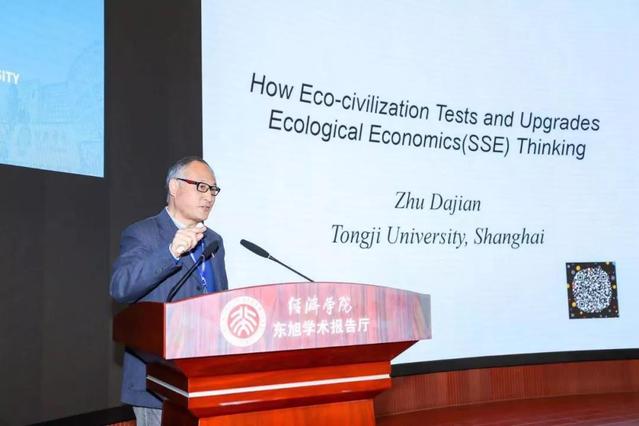11月15日诸大建教授应邀在北京举办的“生态经济与生态文明”国际论坛做主旨发言,诸教授指出1980年代以来世界性的可持续发展运动推动了学术界有关可持续性科学的理论探索,中国的生态文明是当今世界最大的绿色实验室,中国学者要能够并善于讲出可持续性科学2.0的故事。以下是诸教授发言的中英文主要内容:

可持续性科学是对1980年代以来世界性的可持续发展运动的理论探索,中国的生态文明实践是当今世界最大的绿色实验室,可以检验和升级可持续性科学的理论思考。一方面,在可持续发展的理论研究中,新古典进经济学强调弱可持续性,生态经济学主张强可持续性,中国绿色发展为检验强范式与弱范式的争论提供了机会,生态文明是强可持续性导向的发展;另一方面,中国的生态文明思想有助于把强可持续的理论思考提升到新版本,强调发达国家需要走向稳态的绿色发展,而发展中国家需要推进聪明的绿色增长。
从中国的绿色发展实践和政策,可以讨论四个重要的理论问题:
一是关于有物理极限的发展对没有物理极限的增长。强可持续性意义上的绿色发展是有自然资本约束的经济社会发展,中国的生态文明是要实现经济社会发展与资源环境消耗的脱钩。
二是有关绿色转型的B模式和C模式。传统的无极限的经济增长是超越地球生物物理极限的A模式,当今的绿色转型需要有两种替代模式。B模式针对发达国家,在保持人类发展水平的同时把物质消耗足迹和二氧化碳足迹降低到阈值之内;C模式针对中国这样的新兴经济体,在生态足迹不超过阈值的情况下大幅度提高人类发展水平。
三是有关技术效率改进与生态规模控制。新古典经济学试图用效率改进实现绿色增长,无法避免反弹效应导致的生态规模扩张。中国的生态文明强调既要有物质强度控制更要有生态规模控制,要用规模控制激发更大幅度的效率改进。
四是有关可持续性科学研究和生态经济学理论思考的版本升级。1980年代在英美崛起的生态经济学是可持续性科学理论思维的1.0版,强调在生态规模、社会分配、效率改进三个方面进行理论整合,中国生态文明可以引发可持续性科学理论思维的2.0版,要在目标、资本、体制三个维度上进行系统集成的概念创新和思想组织。
How Eco-civilization Upgrades Theory Thinking of Sustainability Science
My main idea is that China’s eco-civilization could revise and upgrade theory thinking of Sustainability Science (SS) from two aspects.One side, China, currently the largest green laboratory in the world, provides an opportunity for us to test and solve the debate between Week Sustainability Paradigm (WSP) based on New Classical Economics (NCE) and Strong Sustainability Paradigm (SSP) based on Ecological Economics (EE). New Classical Economics (NCE) is less possible to give a good explanation and understanding to eco-civilization, but Ecological Economics or Steady State Economics (SSE) could. The other side, eco-civilization could deepen and upgrade theory thinking of SS and especially EE to a new version to fit both developed and developing contexts. Here in some details, I share four critical issues and opinions with you for discussion.
First, about development within limit vs. growth without limit. About relationship between environment and development, we know that while NCE insists on economic growth without biophysical constrains, EE calls for human development within the ecological capacity. (1)To support SSP, as SDGs should be considered to design and implement within the Planetary Boundaries,we do believe that economic growth has biophysical limits or ecological red-lines in terms of material footprint and CO2 emissions.So China has designed energy policies for carbon peak and coal peak, urbanization policies with three control lines for eco-protection, permanent agriculture land and built land, and production and consumption policies for solid waste output peak.)(2)China’s eco-civilization and green transition aims to decouple absolutely economic growth with resource consumption and environment impact.If succeed, that would be a green miracle for both China and the World. For example, China’s new-type urbanization would be expected to decouple with construction land, as Beijing Master Plan 2016-2035 has planned a negative growth of construction land towards 2035.(3)We do believe that critical natural capitals and man-made capitals are fundamentally complementary.Bigger the scale of man-made capitals is getting, smaller the substitutability of natural capitals would become. As two mountain theory said (Green Mountains Clear Water and Mountains of Gold and Silver), China’s modernization should provide not only enough material services and social services but also enough ecological system services.
Second, about Plan B or Plan C towards green transition. While NCE has Plan A with continuing economic growth and believes wellbeing will rise as GDP growth and material consumption, we would look for alternatives for old growth model.(1) We think that there should be two different directions to decouple economic growth with ecological negative impacts.Plan B would be for developed countries with overshoot to keep their HDI level but down their eco-footprints to the limit; Plan C would be for developing countries with undershoot to increase their wellbeing but keep ecological impacts under the limit. From this angel, you could see some policy differences between coast developed areas and hinterland developing areas in China.(2)With Plan C, China would expect to be capable to realize higher HDI with less eco-footprint than the West countries. For example, it is desirable for China to reach higher HDI with less CO2 emissions and material footprint per capita by 2030.(3)China’s Plan C for green transition should consist of both higher resource productivity and higher HDI with appropriate GDP per capita.In last decades, China has greatly improved his resource productivity in terms of material intensity and CO2 emission, and in the future it is desirable for us to see a big progress in HDI and quality of life, to say, by investing in universal social goods like public health and education rather than material-intensity or energy-intensity industries .
Third, about efficiency improvement vs. biophysical scale control. NCE believes efficiency approaches would be enough to reach the green growth but could not answer the challenge from rebound effects. The question is why the sum of material consumption and environmental impact is still increasing when resource productivity has improved a lot.(1) To agree withEE, China realizes that efficiency approaches would work best under the control of the biophysical scale to overcome the rebound effect.So China sets up dual control policies of both material intensity control and biophysical scale control in such fields as resource consumption, CO2 emission and environmental treatment.(2)For policy-making, we would prefer backcasting approaches to forecasting approaches, thinking from objective to measure, from future to present and from natural limits to economic growth speed, not reverse.For example, China will control his energy consumption scale by slowing down the speed of economic growth to reach CO2 emission peak by 2030.(3) We do believes that social innovations would possibly be much better than traditional efficiency improvements.For example, social innovations like sharing mobility systems and public railway systems would have higher mobility service with lower car ownership.
Finally for conclusion, about SS 1.0 with three elements and SS 2.0 with three shifts. Sustainable development contains three aspects of economy,society and environment. If SS 1.0 is characteristic of three pillars and EE 1.0 integrates three elements cross the thought history of economics, from China’s eco-civilization we could develop and organize a more holistic EE 2.0 with three shifts at three levels. (1)In the goal level, we should introduce the viewpoint of wellbeing threshold for a shift from economic growth to human development.Eco-civilization believes that economic growth is important for well-being, but more GDP above some critical threshold (to say, above 20000 USD per capita) would be not necessary, because its marginal benefits would become diminishing.(2)In the capitals level, we should have the viewpoint of ecological threshold for a shift from simple physical capital to a system of three capitals.Eco-civilization understands that ecological system includes social and economic sub-systems and we should pursue a human wellbeing and prosperity within the limit of nature.(3)In the level of governance, we should have the viewpoint of institutional threshold for a shift from separate institutional actions to good governance and partnership from government, market and civil societyto prevent and reduce market failure and government failure.
(转载自:微信公众号:TJ_SEM)

